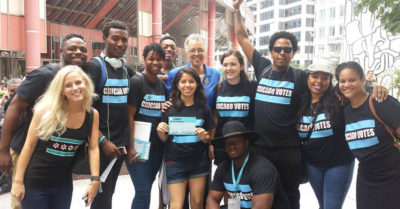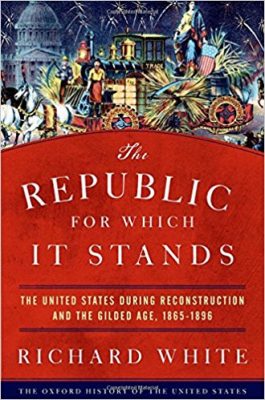
Courtesy of Gozamos
As Americans go to the polls tomorrow, one of the inevitable storylines that journalists and pundits will follow is that of generational conflict, particularly within the Democratic Party. What kind of showing will younger candidates make? And even more importantly, will young people turn out? How will their voting patterns differ from their elders? If large numbers of young people stay home, what will that mean about the future of the American political system? Are they merely rejecting the (older people’s) establishment, or are they rejecting democracy itself?
Generational conflict has become so common a framing device for emerging political, cultural, and economic trends that we are to some degree accustomed to thinking of it as a basic component of any far-reaching process of secular change. Yet it is also a tacitly accepted premise that generational conflict has only been so continuously potent since World War II—that before that event, episodes of efficacious collective youthful dissidence were discontinuous and remarkable. Persistent turbulence between generations may have existed, but the elder generation was generally able to roll over the chop and churn of their juniors’ discontent without much trouble and—more significantly—without much concern or self-reflection.
But perhaps it is a mistake to assume that generational conflict is fundamentally based in diverging attitudes. That, at least, was the conclusion that I felt was suggested by Dan Bouk’s brilliant article “Generation Crisis: How Population Research Defined the Baby Boomers,” in Modern American History. Bouk shows how “the concept of the baby boom… made boomers the scapegoats for more complicated social, political and economic difficulties” that pre-existed their arrival. In other words, population researchers, educators, and politicians (among others) started predicting that the Baby Boom’s demographic magnitude would cause crises—whether by flooding elementary classrooms or clogging the Social Security rolls—long before Boomers actually began using those institutions. Often, these looming Boomers actually stood in for crises that were already present or latent in those institutions: it became all too easy to reconfigure chronic and intractable problems with, say, a city’s education system as an acute crisis brought on by the unprecedented demands of the Baby Boom’s floodtide.
What Bouk’s argument suggests to me is that, when we talk about generational conflict, we ought to pay more attention to ideas about demographics and somewhat less to ideas about cultural values. That is, what may on the surface appear to be a cleavage in political mores may in fact be much more entangled with fears of a demographic catastrophe in the rising generation, fears that are, if not prepolitical, at least phobic in an almost clinical sense: aversive, almost instinctual, deeply visceral, atavistic.
Sharp differences in cultural attitudes and political behaviors, in other words, are a kind of tissue cloaking the skeleton of a relatively inflexible set of ideas about the future of a generation, crude predictions that calcify into conventional wisdom well before that generation has formed its tastes or affiliations. What counts is not whether the young kids like their parents’ music; the brute fact of their generational dimensions and composition determine what kind of narratives will be stretched over their lengthening limbs.
Anxieties about replacement are fundamental in this interpretive frame: who will take over when I’m gone or when I’m too weak to manage my own affairs? Often, this fear is both explicit and yet still nestled within Archie Bunkeresque bluster about the ornaments of the generation gap—personal style, political sentiments, sexual habits.
A fine example is in the novel Angle of Repose, by Wallace Stegner. A historian, Lyman Ward, whose legs have been amputated and whose health is generally failing, is reliant on Ada, a personal assistant who helps him with his personal hygiene. Ada is near his age, but her college-age daughter, Shelley, also becomes Ward’s research assistant, helping him to write a biography of his grandmother, an accomplished artist and frequent contributor to a Century– or Harper’s-style Gilded Age magazine. Although there is no reason to suppose that Shelley would continue Ward’s work should he die before he completes the biography (a persistent fear for Ward), she becomes a magnet for many of his anxieties about what one might call his and his family’s legacy, especially as a conflict with his half-estranged son Rodman develops through the novel. But Ward expresses his more profound anxieties about Shelley as an inadequate replacement largely through shocked or scornful observations of her personal appearance, language, and demeanor—for example, her habit of not wearing a bra. (Which, now that I mention it, is after all a barely sublimated anxiety regarding her procreative/reproductive potential—her ability to properly fulfill her biological role.)
To talk about “replacement” today, though, is not merely to talk about generational cohorts but to talk about race, or rather of racialized fears. No subtextual decoding is necessary: from cries of “white genocide” and “Jews will not replace us” to Donald Trump’s desperate fearmongering about the immigrant caravan of Central Americans traveling to the United States (nicely sent up by SNL here), the demographic is front and center.
These fears of replacement are not perfectly aligned according to generation: the marchers at Charlottesville were mostly young men, and, while I don’t think there are too many sexagenarian antifa, anyone who has seen the crowds at any number of counterprotests or anti-Trump rallies can well attest to the immense numbers of boomers and members of the Silent Generation.
Yet it still makes sense to follow the tendency to generationalize because the logic of “replacement” is generational. And, it should be noted, if there is a scalding fear among Trumpists of being replaced by the wrong kind of people, there is an equal and opposite hope among many anti-Trumpists that the younger generation will learn from boomers’ mistakes—regarding the environment, if nothing else. Often I have seen this hope inflated into something metaphysical: siding with the younger (and ostensibly more feminist, more multiracial, more sexually and religiously tolerant) generation is to be on the “right side of history.”
***
 The occasion of my thoughts about generational divides is a kind of structural or narrative problem I encountered in Richard White’s The Republic for Which It Stands: The United States during Reconstruction and the Gilded Age, 1865-1896. One of the book’s principal arguments is implied by the subtitle: rather than annex the Gilded Age to the Progressive Era (or, as has become customary, to problematize or blur the distinction between the two), White argues for the importance of carrying forward the historiographical themes of Reconstruction into the Gilded Age: the expansion of free labor, contract freedom, economic developmentalism, and the geopolitical “project that involved a vast spatial rearrangement of a kind that later generations would call nation building and still later generations would call ethnic cleansing.” There is a clutch of complicated historiographical arguments embedded in this move, and perhaps I will try to revisit them at a later date.
The occasion of my thoughts about generational divides is a kind of structural or narrative problem I encountered in Richard White’s The Republic for Which It Stands: The United States during Reconstruction and the Gilded Age, 1865-1896. One of the book’s principal arguments is implied by the subtitle: rather than annex the Gilded Age to the Progressive Era (or, as has become customary, to problematize or blur the distinction between the two), White argues for the importance of carrying forward the historiographical themes of Reconstruction into the Gilded Age: the expansion of free labor, contract freedom, economic developmentalism, and the geopolitical “project that involved a vast spatial rearrangement of a kind that later generations would call nation building and still later generations would call ethnic cleansing.” There is a clutch of complicated historiographical arguments embedded in this move, and perhaps I will try to revisit them at a later date.
What this means in practical narrative terms, though, is that White for the most part tells his story through the lives of one generation of men and women who came of age in the Civil War, the generation that Oliver Wendell Holmes, Jr. famously said was “touched with fire” in their youth. This approach has many rewards: as with Railroaded, White adroitly and imaginatively uses biographical vignettes to add a kind of intimacy and emotional depth to his enormous canvas.
But using an implicit generational frame also creates a serious problem. Apart from a handful of exceptional individuals like Holmes, most of the energy and creativity of that Civil War generation had run out somewhere in the 1880s, and White’s narrative thus limps somewhat dully into the 1890s as one feels the clock winding down on the cohort of men and women who carried the story through the 1870s and early 1880s. The exhaustion of this generation by the 1890s runs counter to White’s explicit argument for taking Reconstruction and the Gilded Age as a single unit—1865-1896.
White demonstrates that he is aware of this problem, and he notes that other historians of the Gilded Age—especially intellectual historians—have faced it as well. It has particularly been a matter of concern to historians of social science, and the books by Nancy Cohen and Thomas Haskell (The Reconstruction of American Liberalism, 1865-1914 and The Emergence of Professional Social Science, respectively) rest their whole arguments on particular interpretations of the conflict between the older generation of quasi-professional liberals and the rising generation of fully professionalized progressives.
To put the matter more bluntly, it is damn hard to narrate the history of the latter half of the nineteenth century when you have a generational divide to scale right near the end. The “Greater Reconstruction” frame makes less and less sense as the men and women for whom the Civil War and Reconstruction was a searing trial of youth lose their place in the American pageant. White’s attempt to maintain the “Greater Reconstruction” frame into the 1890s is just not historically convincing or narratively satisfying.
But is there another option? What about a Greater Redemption, with the dates 1871 to 1924 or 1927? From the moment after the last Enforcement Act passes to the moment that Congress passes the Johnson-Reed Act restricting immigration, or the moment that Oliver Wendell Holmes, Jr. himself avers that three generations of imbeciles are enough in Buck v. Bell? A long five decades of racial revanchism, of fears of the fin-de-siecle’s version of “white genocide”—“race suicide.” Fifty years of demographic angst, fifty years of fretting about how the decimated generation that won and lost the Civil War could be replaced.
I don’t have to draw the parallels for you. But I’ll be listening for them, tomorrow and after.

0